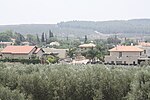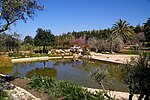Mini Israel
2002 establishments in IsraelMiniature parksMuseums established in 2002Museums in Israel

Mini Israel (Hebrew: מיני ישראל) is a miniature park located near Latrun, Israel in the Ayalon Valley. Opened in November 2002, the site contains miniature replicas of hundreds of buildings and landmarks in Israel. The tourist attraction consists of about 350 large models of notable buildings. The scale of 1:25 produces skyscrapers that tower over an adult and historic churches taller than a child.
Excerpt from the Wikipedia article Mini Israel (License: CC BY-SA 3.0, Authors, Images).Mini Israel
Miniture Ben Gurion Airpot, Mate Yehuda Regional Council
Geographical coordinates (GPS) Address External links Nearby Places Show on map
Geographical coordinates (GPS)
| Latitude | Longitude |
|---|---|
| N 31.842491666667 ° | E 34.96725 ° |
Address
מיני ישראל
Miniture Ben Gurion Airpot
Mate Yehuda Regional Council
Jerusalem District, Israel
Open on Google Maps











